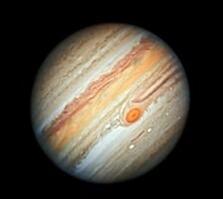JUPITER
|
Jupiter is the largest planet in the Solar System- over one thousand Earths could fit inside it! Its visible surface is made of cloud bands of water and ammonia, separated by strong jet streams. Deeper down, the atmosphere turns into a hot super-ocean. It likely has an Earth-sized rocky core at its center. The Great Red Spot is a massive, centuries-old storm that is larger than the Earth. Dust from some of Jupiter’s moons form a faint ring system that circles the planet.
|

